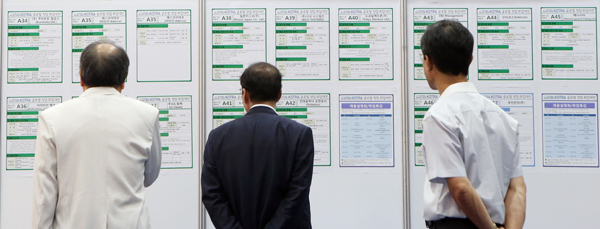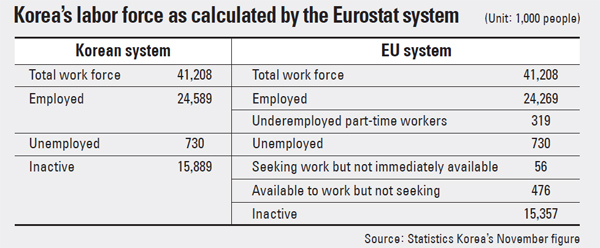Jobless gauge seen as divorced from reality

Job seekers scan the latest positions advertised on a job fair board at Coex in southern Seoul on Monday. [YONHAP]
Statistics Korea is again taking flak for releasing a monthly unemployment rate that fails to reflect the reality of the job market.
An internal report by the Ministry of Employment and Labor showed that when the unemployment statistics were recalculated according to the system used by the European Union, the rate went up.
Last November, the Korean agency put the jobless rate at 2.9 percent, but under the EU system it rose to 5 percent.
Even this would still be considered very low in global terms, however, with the U.S. ? which uses a system similar to Korea’s ? posting 8.7 percent that month, and crisis-hit Spain having seen its unemployment rate soar to 20 percent, as gauged by the EU.
The Korean system is based on three indexes used by the International Labor Organization (ILO): The number of employed people, unemployed people and “inactive” people.

However, the EU takes into account three more measurements, according to the report: Underemployed part-time workers, or people who work part-time but want to extend their working hours; those who are seeking work but who are not immediately available, which refers to those who have been searching for work for at least four weeks but who are unavailable to start for the next two weeks or more; and those who are available to work but not currently seeking.
The second category would apply to students who have delayed graduating, for example, by a semester, in order to keep job hunting and escape being labeled “unemployed” given the negative stigma of having that on your resume.

Under the EU system, people who fall under the latter two categories are considered “unemployed,” whereas in Korea they are deemed “inactive.”
Critics say the Korean barometer has effectively created a disparity between the job market, or how people actually feel, and the official statistics that may paint a slightly rosier picture.
In November, almost half a million people were classified as “inactive” in Korea who would have been deemed “unemployed” in the EU. The vast majority were seeking work but not immediately available, with just 5,600 people. Those under “available to work but not seeking jobs” amounted to 476,000 people.
This is not the first time Statistics Korea has been blasted for its hazy jobless figures. In October, the Korea Development Institute (KDI), a state-run think tank, said the system should be changed as many job seekers had become skeptical of the figures being announced. The KDI claimed this undermined the credibility of the figures and, by extension, the agency.
The statistics office responded by digging in its heels and directing critics’ attention to the ILO, whose international standards it dutifully adheres to.
By Lee-Ho jeong [ojlee82@joongang.co.kr]










with the Korea JoongAng Daily
To write comments, please log in to one of the accounts.
Standards Board Policy (0/250자)